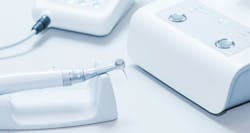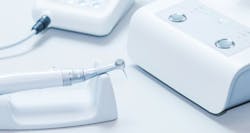High-impact, low-cost technology updates for new owners of existing practices
I distinctly remember the evening I closed on my practice. The day was overwhelming, exciting, and exhilarating, but when everyone left that evening, the office was silent. I had just signed contracts and borrowed more money than my mortgage, car, and dental school loans combined for what I knew would be my dream practice, but as I looked around in that moment, all I saw was outdated technology.
I knew how I wanted my practice to be and look, and I immediately felt disheartened. After all, how could I have the premier practice in my area without up-to-date equipment? I am sure that many other new business owners have felt this way too. Fortunately there are some technology updates you can invest in that will have a meaningful impact on your patients and practice at a substantially lower cost than a complete office remodel.
Digital radiography
When I purchased my practice, I knew I could not travel back in time with my procedures and efficiency. The first technology upgrade that I invested in was digital radiography. I decided to invest in DEXIS, predominantly because I was familiar with it and it easily integrated with my patient software. We have not experienced any complications with our sensors, and digital radiography has been a valuable technology advancement and time saver for the practice.
Our patients are impressed at how quickly and easily we can capture an image. In addition, the image is available on a computer screen right in front of the patient, which facilitates patient education and informed consent. Patients also value the significant reduction of exposure to radiation.
Electric handpieces
Another notable upgrade is the incorporation of electric handpieces. Patients appreciate the noticeable reduction of the “drilling sound” in the office and during procedures. Dentists who use electric handpieces appreciate the consistent torque of the handpiece, which helps to create more efficient, smoother, and better tooth preparations and improves caries removal. When sectioning and removing crowns, or when removing existing restorative material with an electric handpiece, the bur travels through those materials with much more ease and fluidity. In my experience, the bur may not cut as efficiently with some air-driven handpieces, resulting in chattering noises and a less efficient cut. Moreover, polishing composites, ceramics, and metals is more efficient and effective using electric handpieces.
One to consider is the Electromatic series by KaVo. The Electromatic Premium offers the most versatility and features; there is a 4.3-inch touch screen, and the system is intuitive and user friendly. The system can be preprogrammed and the settings can be easily changed from high speed to low speed or to endo mode, which allows for varying torque controls in each setting.
There are five speed programs in prep mode. Changing speed is simple, using a sliding bar on the touch screen. This is particularly useful for polishing the margins of crown preparations. There are five programs available in endo mode with 10 files each. In addition, there are 20 preprogrammed file systems to set up the maximum torque and speed for each file automatically.
To further improve efficiency, one or two motor systems are available. It is common to own one electric handpiece unit and constantly change the handpieces when you want to change the torque or switch from a friction-grip bur to a latch. With this system, you can have both handpieces ready to go! This system will greatly enhance the quality and efficiency of all restorative and endodontic procedures.
Intraoral camera
One challenge that many dentists face when buying an existing practice is case acceptance of new treatment recommendations for existing patients. Many patients meet their new dentist with trepidation and concern that care is being recommended to help finance their new dentist’s endeavor, not because it is needed. One simple and cost-effective technology that can help with this is the intraoral camera.
Intraoral cameras break down communication barriers; they can easily capture images of teeth and intraoral structures, so patients can actually see what the dentist is seeing. For instance, I have found that it is much easier to explain the implications of not pursuing treatment of cracked teeth with a photograph than it is with just words. When intraoral photographs are used in treatment discussions, patients have a better understanding of their own oral condition, and treatment acceptance is much higher. In addition, dental hygienists can document calculus buildup and show before-and-after photos during dental hygiene appointments. This encourages communication and trust between the patient and dental professional.
When incorporated into the private practice for the first time, intraoral cameras also offer a method of documentation and communication that the patients have never experienced before. When it is decided that a tooth needs monitoring for clinical changes, how is it possible to remember every detail of that tooth without photography? In addition, dentists can take photographs before, during, and after treatment to aid in communication with a patient or specialist and to encourage insurance reimbursement.
Which one should you get? There are many excellent intraoral cameras on the market, and I can tell you how I selected mine. I went to my local dental convention and scheduled time with my dental hygienist. My only deal maker/breaker was that I wanted the camera to have a seamless integration with my electronic health record software. After that was confirmed, I wanted the camera to be comfortable in my hygienist’s hands and cost effective. I also ensured that the company offered training and support for my team. I believe that team participation in the decision-making process helps to encourage the long-term use of the technology.
When a dentist buys an existing practice and wants to make updates with new technology at a relatively low cost, digital radiography, electric handpieces, and intraoral cameras fit the bill perfectly. These technologies are relatively low cost and are easy to acquire and implement. In addition, electric handpieces, digital radiography, and intraoral cameras not only provide the office with excellent equipment that improves care, but they also impress patients, improve communication, save time, and encourage treatment acceptance.
Pamela Maragliano-Muniz, DMD, is an editorial director for Pearls for Your Practice: The Product Navigator, an e-newsletter from DentistryIQ and Dental Economics. She was a dental hygienist before earning her DMD from Tufts University School of Dental Medicine and her certificate in advanced prosthodontics from the UCLA School of Dentistry. She teaches, and she maintains a private practice in Salem, Massachusetts. In 2010 her practice was named the Adult Preventive Care Practice of the Year by the American Dental Association.


